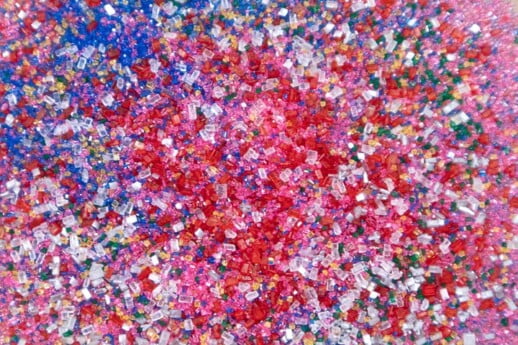
Sugar, in one form or another is the most used sweetener in a bakery. It is used not only for sweetening, but as a tenderizer, moisturizer and for contributing brown color and a caramelized or baked flavor.
Sugars can be dry powders consisting of fructose, sucrose, glucose, maltose and lactose.
Liquid syrups include, honey, invert sugar, corn syrup, molasses, sorghum, maple syrup, and golden syrup.
While used for sweetening, sugar also provides many functions including their hygroscopic properties which simply means their ability to attract and hold water.
Tenderizing
After the sugar is dissolved, it prevents gluten formation, protein coagulation and starch gelatinization. Sugars delay the formation of structure and as a result they tenderize.
The more sugar that is added, the more delayed structure formation, the more tender the baked good.
Too little sugar in baked goods causes the structure to form too early before it can expand from the heat/steam in the oven. The product will be compact with a peaked and cracked top with little color.
Too much sugar will result in too little structure formation and it either won’t rise or will rise but collapse as it cools. It can cause the product to expand over the edge of a cupcake liner or pan, then collapse in the center.
Sugar Retains Moisture
Retaining moisture can be good or bad, depending upon what is being baked. While desirable in cakes, muffins, quick breads, scones, etc., it can ruin meringue.
The hygroscopic nature of sugar increases the softness and moistness in baked goods. It can also postpone drying out. Syrups such as invert syrup, honey, and high fructose corn syrup add more moistness and prevent drying out longer than dry sugars.
Provides Brown Color
While brown sugars and syrups naturally provide a darker color to baked goods, most sweeteners contribute brown color through the process of caramelization and Maillard browning. Cooked sugar has a caramelized taste. The flavors of Maillard browning are diverse including roasted coffee and cocoa beans, roasted nuts, maple syrup and molasses.
Browning occurs when sugars are heated to a high temperature. Maillard browning is similar but proteins, in addition to the sugars, take part in browning faster and at a lower temperature. Because of the increased protein in bread flour, products made with it will brown faster than those made with all-purpose, pastry or cake flour.
Additional Functions
Sugar assists in leavening because there is air between the irregularly shaped crystals. When dry sugar is added to batters and doughs, air is added. Air is a leavening agent.
Stabalizes Eggs. Beating egg whites, yolks or whole eggs with sugar makes them less likely to collapse. Think angel food, sponge, genoise and anytime butter and sugar or sugar and eggs are beaten until light. The light color is the air that is beaten in. That air expands in the heat of the oven and causes the product to rise.
In the case of meringue cookies or pavlova where egg whites are beaten with sugar to stiff peaks, they are dried out in the oven rather than baked at low temperatures to keep them from expanding and cracking.
Sugar provides food for yeast helping it grow faster. Often times, even in breads,itis added to help the yeast along without simply adding more yeast.
Reduce the iciness and harshness in frozen desserts by lowering the freezing point and holding onto the water preventing ice crystals.
Prevents Microbial Growth at high levels by lowering the water activity which is why the yeast in rich, sweet doughs rise more slowly than lean doughs.
Adds sheen to icings. Syrups, in particular add a glossy sheen to icings and ganache which is why corn syrup is often an ingredient.
Promotes Crisp Crust on Some Baked Goods. When moisture evaporates during baking, a crisp crust will form. Sugar promotes this crispiness as it recrystallizes during cooling. This is particularly noticeable in cookie, brownies and pound cake recipes high in sugar and low in moisture.
Spread in Cookies. The more dissolved sugar in the cookies, the more the cookies will spread. The finer it is, , the more they will spread. Although powdered sugar is a finer grind, the cornstarch helps prevents the spread of cookies.
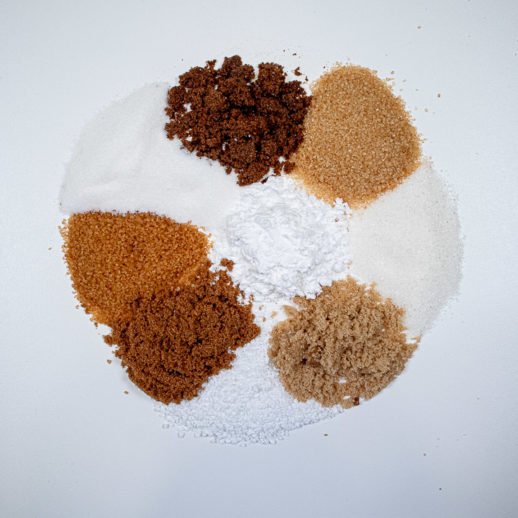
White Sugars
Granulated sugar is a highly-refined, multi-purpose sugar made from sugar cane, sugar beets, or a combination of the two. It has had all of the naturally present molasses refined out of it. Considered a pure sugar, it has been crystallized and centrifuged then sent through a granulator where the crystals are dried, separated, and screened. It is the sugar most commonly used in baking.
Baker’s Sugar – is granulated sugar that is more finely ground, also referred to as superfine sugar, ultra-fine sugar or caster sugar. It is used professionally because it dissolves more easily in recipes and is particularly good for meringues and creaming butter and sugar together.
Caster Sugar – see Baker’s sugar as it is the same thing. The name caster sugar is used in Great Britain and it present or former colonies.
Confectioners sugar is also referred to as powdered sugar . 10X powdered sugar is the most finely powdered. It is used for dusting desserts, frostings, icings, and candy because it provides a smooth consistency. Because it dissolves so easily, it is often used in beverages. Confectioners sugar or powdered sugar contains about 3% cornstarch to prevent it from clumping.
Swedish Pearl Sugar consists of thick, white, opaque, white sugar that retains its shape under the heat of the oven. It is used for decoration as well as texture and taste particularly in Scandinavian baking.
Belgiun Pearl Sugar is the same as Swedish Pearl Sugar but is larger. It is used extensively with Liege Waffles.
Sanding Sugar is used for decoration reflecting light so as to sparkle. It comes in colors as well as clear with large crystal that hold up well to the heat of the oven.
Coarse Sugar has larger crystals than sanding sugar but is used for decoration also.
Sugar Cubes consist of granulated sugar that has been compressed into small squares. In the past it was used to sweeten tea. Often, flowers or other designs were painted on them.
Donut Sugar or Snow Sugar is a specially developed powdered sugar that will not dissolve or melt on baked items. It can be used for decorating donuts, breakfast pastries, fruit tarts, cakes and cookies. This is especially necessary when finishing something that is moist because this sugar will stay white and powdered. It can also finish a frozen product and now melt when thawed. Other names by which it is known are White Snow Sugar, Non-Melting White Donut Sugar, Non-Melting Powdered sugar and Snow White Non-Melting Topping Sugar.
Brown Sugars
Brown Sugar, Dark and Light – Brown sugar is the less refined version of granulated sugar in which some of the molasses has been retained. Less molasses is retained in light brown sugar than in dark brown sugar. It can also be granulated sugar to which molasses has been added back. Brown sugar is more difficult to measure correctly by volume. If measuring this way, always pack the cup. The most accurate way to measure is by weight. One cup of either brown sugar weighs 200 grams. Either brown sugar is also low enough pH for it to be deemed slightly acidic and will activate baking soda when the two are combined.
Demerara Sugar is raw sugar than has been nominally refined. It has large grains, is amber colored and has a subtle molasses flavor. It is often used for topping muffins and scones.
Turbinado Sugar is also minimally refined raw sugar made after the molasses has been spun off from the sugar,. As a result, the crystals are large and golden. Turbinado sugar is finer than Demerara sugar and often used in tea and coffee.
Muscavado Sugar is also known as Barbados sugar is a robust, least refined raw cane sugar in which all of the molasses is retained. It comes in a dark and light version with a rich, intense flavor. Muscavado sugar has a wet, sandy texture and has a stronger taste than regular brown sugar due to the increased molasses. Light muscovado sugar is about one sixth molasses, and dark about one third molasses. It retains the most complex sweetness including the butterscotch flavors in candies and puddings.
Liquid Sugars
Sweeteners such as corn syrup, invert syrups, honey, and molasses prevent moisture loss and also help prevent sugar crystallization. These sweeteners make soft, moist baked goods.
Honey comes in many flavors depending upon where the bees are. It is used as a sweetener in baking and to finish desserts such as baklava.
Molasses, Dark & Light is a thick, dark syrup made by boiling and reducing sugar cane which produces sugar crystals and molasses. There are usually three cycles with each cycle yielding a darker and more bitter syrup. It also comes in mild, the first extraction and dark which is the second. Black strap molasses is the third and the most intense and bitter.
Sorghum syrup was introduced into the south in the early 17th century from Africa with the slave traffic. It has a thinner consistency than molasses and was often used as a drizzle on cakes, biscuits and bread.
Maple Syrup has multiple which vary in flavor and thickness. It is used for both sweet and savory applications including as a flavoring for pies and cookies.
Corn Syrup is made from the starch of corn and contains varying amounts of sugars. It is used in foods to soften texture, add volume, and prevent crystallization of sugar. It come in a clear variety that is enhanced with salt and vanilla and the dark corn syrup that contains molasses.
Golden syrup is a translucent, golden-amber colored, sweet syrup, which was created in London in the 1880s. It is made from white sugar which has been inverted, meaning that the sucrose has been broken down into two simpler sugars, fructose and glucose. Beautifully golden, hence it’s name is has a light caramel flavor. It is used where honey or corn syrup is used and as a syrup over pancakes, waffles, ice cream, etc. (I can eat this by the spoonful all by itself.)


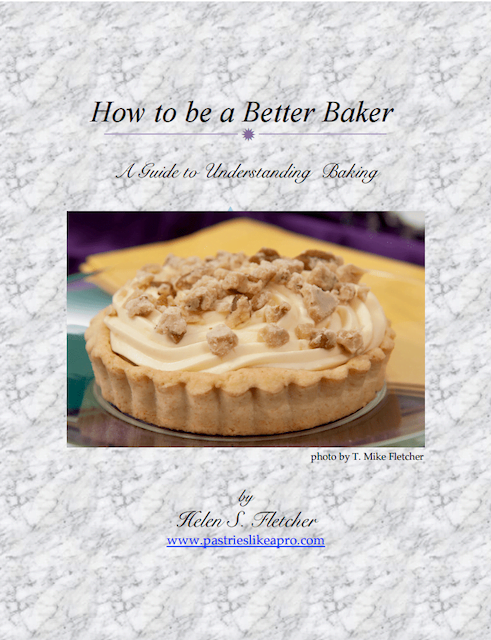

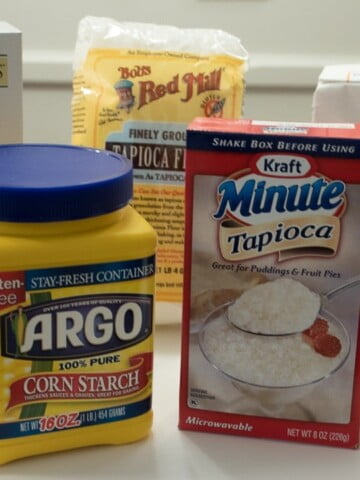
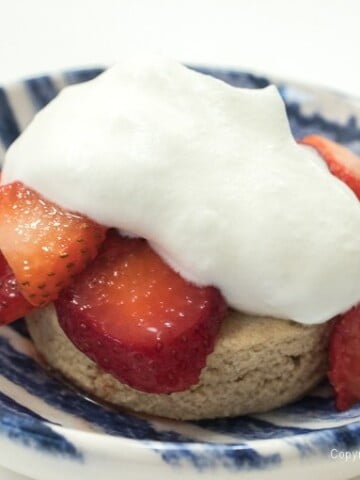
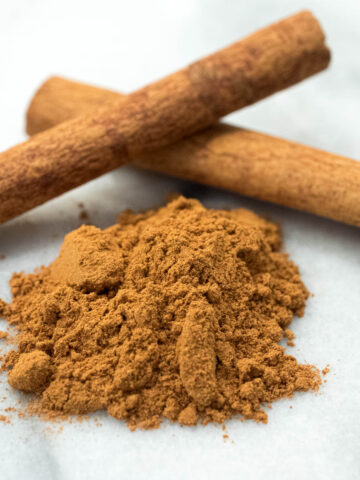
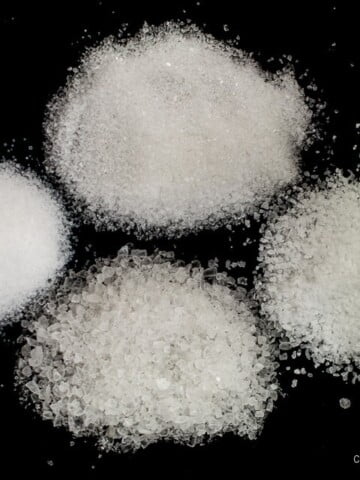
Art Fink says
Who knew there was so much to learn about sugar?!? Thanks Helen, very helpful!
Helen S Fletcher says
Hi Art - There is a lot for sure. I'm going to use a couple of the sugars for cookies to see what the differences are now that I have them. I'll report on them.
Erna says
Thank you for the information. I always wondered what the difference was between the different sugars.
Laraine says
Thank you for an excellent summary of the types of sweeteners and their properties. I know I will refer to this article again, when troubleshooting a recipe or thinking about interchanging sweeteners.
Helen S Fletcher says
You're welcome Loraine.
Linda Vieth says
I agree. Thank you for giving us an education on sugar. I am a type one diabetic and I love baking for others not me. I have been using coconut sugar and coconut flour in all my baking to lessen the glycemic effect. I have had success. Both darken the end product but everything remains tasty. Again, thanks.
Helen S Fletcher says
Hi Linda - my grandson is a type 1 and I have to admire how he handles it. That's a hard one. Good for you that you have figured out how to keep doing what you love and for sharing. I've seen the coconut sugar but not flour. Interesting.
Jessica P says
Thank you, Helen….I’ve always wondered what golden syrup was!
Helen S Fletcher says
Hi Jessica - it's the best. Hope you get to try it sometime.
Molly F.C. says
Terrific! Thank you for taking the time to write such an informative and valuable post.
Helen S Fletcher says
Good morning Molly - Happy to see someone up with me this morning. You're welcome. More to come on Thursday.